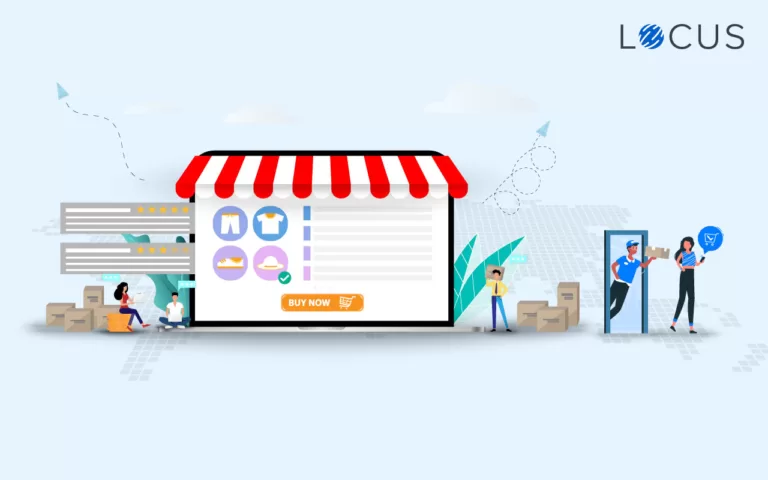Supply Chain Optimization
How Supply Chains can Reduce Carbon Footprint with Logistics Planning Software
Dec 29, 2020
7 mins read
How to reduce your supply chain carbon footprint with Logistics Planning Software? Check out how Locus logistics planning and green logistics strategies can help you in reducing your supply chain carbon emissions and fuel consumption.

Due to climate change and reckless exploitation of natural resources, the environment is deteriorating rapidly. Intense droughts, storms, heatwaves, rising sea levels, melting glaciers, and warming oceans are just some of the visible impacts of global warming and climate change on the environment. Increasing temperature and carbon emissions are also harming animals, destroying wildlife habitats, impacting human health, and depleting the quality of life in many ways.
Towards the end of 2019, Australia was engulfed by raging forest fires, a period which is now known as Black Summer for the country. In early 2020, swarms of deadly desert locusts, accelerated by climate change, entered Uganda after ravaging parts of Kenya and causing food shortages. At least 19 people died in the US state of Tennessee as a result of a heavy tornado that also causes major damage to buildings, roads, bridges, utilities, and businesses.
Industries, e-commerce businesses, corporate entities, and supply chain enterprises contribute majorly to the increase in greenhouse gases and carbon emissions. According to the U.S Energy Information Administration, transportation is the largest source of carbon emissions in the United States. More than three-quarters of the greenhouse gas (GHG) emissions associated with many industry sectors come from their supply chains. The transportation sector — comprising traffic from cars, trucks, planes, trains, and boats emits 1.9 billion tons of CO2 annually.
If on one hand, modern supply chains are delivering merchandise fast and keeping the promise of same-day and next-day deliveries to their customers, they are also causing an ecological imbalance.
The e-commerce industry requires fewer paper resources due to paperless offices, paperless data management, and paperless transactions but relies heavily on a transportation system that is highly energy and pollution-intensive. Moreover, E-commerce activities lead to unmanageable piling up of corrugated cardboard boxes, plastic bags, and other packaging waste in landfills.
Supply chain enterprises have a prime social responsibility of adopting sustainability and controlling the devastating impacts of logistics and transportation activities on the environment. ‘Go Green,’ ‘Green Corporates,’ and ‘Green Supply Chains’ are therefore trending buzzwords today.
Green Logistics is Good Logistics
Green logistics typically refers to all the initiatives taken by businesses to minimize the overall ecological impact of their logistical activities. This includes reducing carbon footprint and ecological wastage in all forward and reverse flows of products from point A to B, and the transport, storage, and distribution of goods throughout the supply chain. Green logistics aims at transporting and delivering goods at the lowest possible cost while minimizing the overall environmental impact in the process.
Experts believe that green logistics is good logistics as it not only helps reduce carbon footprint but also leads to supply chain efficiency and helps lower operating costs.
Some of the world’s leading supply chain enterprises such as DHL Logistics, FedEx, Maersk, and Alibaba Group have implemented sustainable logistics practices in their businesses, letting go of energy-intensive and pollution-prone logistics processes.
The Role of Logistics Planning Software in Reducing Carbon Footprint
An emerging solution to reduce carbon emissions and the ecological impact of logistics is the digitization of supply chain operations using logistics planning and route optimization software.
Broadly speaking, route planning software uses Machine Learning and AI-led algorithms to determine the shortest, most optimal, and cost-effective route between any two points on a map. Delivery route optimization has some environmental benefits apart from being a smart choice for supply chain enterprises.
Smart Network Planning
For many industries, the supply chain comprises multiple steps, from sourcing raw material to transporting finished goods to widespread warehouses and then distributing them to retail outlets or customer locations. With the help of a route optimization solution, enterprises can optimize network designs throughout the supply chain, including the physical flow of goods from one location to another, accurate placement of supply chain nodes, warehouses, and distribution hubs as well as multi-echelon inventory optimization. Efficient network planning improves distribution efficiencies and reduces energy consumption for businesses.
Delivery Route Optimization
When planning delivery dispatches to a few customers, manual route planning might be effective. But when it comes to thousands of daily deliveries spread across various locations, pen and paper planning tends to be inaccurate. Route optimization software automates daily logistics operations by planning daily dispatches and delivery routes, considering real-world constraints such as zone-based restrictions, traffic conditions, and rider preferences. Optimal route planning results in faster deliveries, lesser distance covered, and thus, less fuel spent on the ground.
Improved Supply Chain Visibility
Advanced route optimization software helps logistics managers track and monitor ground operations in real time, improving end-to-end supply chain visibility and traceability. With the help of real-time visibility tools, it is possible to mitigate fuel wastage during idle hours or in traffic. Companies can also accommodate dynamic orders or pick returns when vehicles are traveling empty, resulting in fewer empty miles, often called “deadhead” miles.
Fleet Capacity Utilization
Efficient fleet management is crucial for successful logistics operations and reducing the supply chain carbon footprint. Logistics planning software proposes an ideal-sized fleet for delivery/distribution operations as well as the number of vehicles required on the ground to ensure that all vehicles are adequately utilized. Accurate loading of shipment in the right-sized fleet leads to significant reduction in fuel consumption and thereby reduced fuel costs for the business.
Overall, digital technologies have the potential to enable a 20% reduction of global CO2 emissions by 2030 according to the Global e-Sustainability Initiative. Route Optimization and Logistics Planning software results in lesser miles driven, fewer vehicles used, and reduced fuel consumption for supply chain enterprises. All of this results in lower carbon emissions and less pollution for the environment.
Locus offers end-to-end logistics planning and optimization solutions to supply chain enterprises, helping reduce fuel consumption and carbon footprint. Get in touch with our experts to know more.

Download E-Book on “Supply Chain Sustainability and Profitability with Green Logistics” for Free!

“Climate change is real — as real as COVID-19. Adopting green logistics is not only good for the environment and society at large, it is also more efficient and helpful in lowering operating costs for supply chain enterprises.”
— Download E-Book for Free!
FAQs:
The best way to reduce your carbon footprint is by minimizing the use of renewable energy, reducing non-biodegradable waste, making more use of recycled products and embracing a minimalist lifestyle.
Greenhouse gas emissions from transportation are about 28.2% of total U.S. greenhouse gas emissions, making it the largest contributor of U.S. greenhouse gas emissions.
The transportation sector — comprising traffic from cars, trucks, planes, trains, and boats emits 1.9 billion tons of CO2 annually.
Air traffic contributes to less than 2-3% of the global CO2 emissions, while road traffic accounts for around 10% of direct carbon emissions. Still, planes remain among the most polluting means of transport, together with cars.
Green logistics is not just efficient for your business, but also significantly reduces your carbon footprint. At Locus, we understand that sustainable logistics is the best way forward for long-term growth and help businesses achieve sustainability with AI in the supply chain.
![[Infographics] Reduce Carbon Footprint with Green Logistics](https://locus.sh/assets/img/infographic/resources/green-logistics-to-build-a-sustainable-supply-chain.jpg)
Infographic by Locus
<a href="https://blog.locus.sh/reduce-the-carbon-footprint-of-your-supply-chain/" target="_blank" style="text-align: center; display: block;"><img loading="lazy" src="https://locus.sh/assets/img/infographic/resources/green-logistics-to-build-a-sustainable-supply-chain.jpg" alt="[Infographics] Reduce Carbon Footprint with Green Logistics" style="width:100%;height:auto;max-width:750px;margin:auto;"></a><br/>Infographic by <a href="https://locus.sh/">Locus</a>
Related Tags:

E-Commerce
D2C trend is all set to take the centre stage in Europe
“87% of retail brands in the U.K. and the U.S. have said they plan to launch a D2C channel at some point in the future, while 23% said they will do so within the next 12 months, according to research by Brightpearl.” One of the worst affected regions due to the COVID-19 pandemic is the […]
Read more
Last Mile Delivery Optimization
8 Factors to Consider When Choosing a Vehicle Route Optimization Software in 2021
The new wave of coronavirus has made life tough again and hopes of easing restrictions have taken a back seat. Social distancing norms have become much stricter and consumer behaviour has seen a massive transformation. The e-commerce demand spike has forced logistics companies to maintain productivity and improve their customer service at the same time. […]
Read moreMOST POPULAR
EDITOR’S PICKS
SUBSCRIBE TO OUR NEWSLETTER
Stay up to date with the latest marketing, sales, and service tips and news


How Supply Chains can Reduce Carbon Footprint with Logistics Planning Software